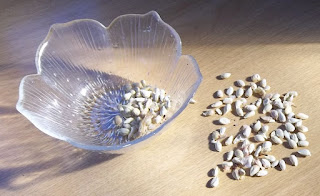Sorry about the silence on my blog - it was an up-and-down week last week, and then yesterday I had to have a (back) tooth extracted, which left me feeling sorry for myself for most of the day...
I have come to the conclusion that I have been over confident. I thought our house would sell quite quickly. Guess I didn't work the effect of the recession enough into the equation. Only two viewings in three months - looks like we could be in it for the long haul... Even the property over the road, which is also for sale, has only had two viewings in three months.
I have come to the conclusion that I have been over confident. I thought our house would sell quite quickly. Guess I didn't work the effect of the recession enough into the equation. Only two viewings in three months - looks like we could be in it for the long haul... Even the property over the road, which is also for sale, has only had two viewings in three months.
And, because of the potential sale of our home, I have not given much thought to my town veggie garden this year. I wasn't terribly inclined to put my heart and soul into it - in fact, honestly, I barely gave it a thought - all my energies have been channeled into planning on getting the farm one up and running. The truck loads of compost (and some topsoil) which will have to be delivered and mixed in with the clay, the purchase of the poles for the "shelter", the purchase of the shadecloth, and to run, and connect, the irrigation from the timer - well, someone has to water it when we're not there. LOL
 |
| A much smaller version of the shade cloth shelter that I anticipate having on the farm.. |
So in the past week I have sown four different types of tomatoes, a whole bunch of capsicum, mixed lettuce seeds, radish, beans and I have ordered some seeds from my heirloom seed suppliers up country.
I already have some parsnips, carrots, swiss chard, beetroot, garlic and onions, growing - although they need more sun than they are currently getting.
That also is a major problem with my town garden. Definitely not enough sun in the winter months.
What am I complaining about, I hear you thinking, for you in the colder northern hemisphere, who are restricted to growing your vegetables in the spring / summer only.
But my winter vegetables need sun! Just like my solar oven...
LOL In fact, talking about capsicum - I found this one hidden in a corner and still growing from last season - it is still bearing a pepper - in perfect condition. I'm going to leave it, and see if it bears any more, for the top of the plant has new shoots...
Ah well, I guess having my seeds planted into trays, pots, loo rolls and empty egg shells and lined up like a marching column of soldiers in the thin sliver of sun that I have in my "nursery" area, will have to do - for now.
That also is a major problem with my town garden. Definitely not enough sun in the winter months.
What am I complaining about, I hear you thinking, for you in the colder northern hemisphere, who are restricted to growing your vegetables in the spring / summer only.
But my winter vegetables need sun! Just like my solar oven...
LOL In fact, talking about capsicum - I found this one hidden in a corner and still growing from last season - it is still bearing a pepper - in perfect condition. I'm going to leave it, and see if it bears any more, for the top of the plant has new shoots...
 |
| Last season's capsicum - the plant looks bedraggled but there is new growth at the top |
At least this season I am also equipped with new pest control ideas to hopefully combat the snails and cutworm.
I'm sure, between the loo rolls...
...the copper scouring pads...
...the egg shell halves...
...and the diatomaceous earth...
...and the diatomaceous earth...
...I should be able to thwart most of their nasty advances.
This is a work in progress - and I WILL let you know which methods are successful and which aren't - after all, sharing is caring LOL
By the way, I also found this somewhere on the Net. If you have a surplus of CD covers, (or your children / grandchildren do) this looks like a nifty way of putting them to good recycled use...
Whatever works - and doesn't involve chemicals in any form, and is fulfilling a recycled purpose - is definitely a plus in my book.


















































